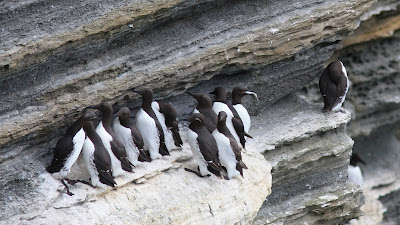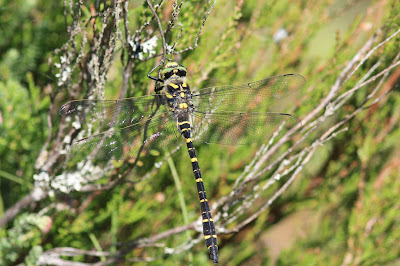Nine hardy souls braved the early morning wind and rain to meet at the ferry terminal at Lyness in Hoy, for a gentle amble up to some bog pools on the southern side of Wee Fea. The eight folk who joined me varied in dragonfly experience, but they each brought plenty of enthusiasm for all wildlife, so prospects were reasonable for a good day.
The initial climb was quite sheltered, but two miles later, as we neared the first pools, a westerly wind was beginning to make its presence felt. In the absence of any direct sunshine, there weren't any dragons or damsels on the wing, so we began to search for roosting individuals amongst the rushes at the pool edges.
The group soon spotted a few Emerald, Large Red and Common Blue Damselflies, and began photographing the more approachable insects, a task made trickier by the afore-mentioned breeze.
 |
| Photo courtesy of MT |
 |
| Photo courtesy of JT |
As the clouds thinned and the temperature rose, a few Black Darters flew by, most of which were yellow and looked as though they had only recently emerged. However, the occasional mature individual was seen, including this male which actually became too hot in the brief spell of warm sunshine. It began 'obelisking', pointing its abdomen towards the sun, effectively limiting the surface area of its body able to absorb heat from the sun.
After a picnic lunch, we began the return descent back down the hill. The second site for the day was a larger bog pool which was located in a more sheltered location in the lea of the hill. For this reason, there were many more insects present, with butterflies, moths, bees and hoverflies all vying for our attention. But perhaps the most intriguing find was a Marsh Speedwell, a small plant with the characteristic blue Speedwell flower, but with leaves more akin to a Willowherb.
This site was predominantly populated by Black Darter and Emerald Damselflies.
The female damselfly above was in tandem with a male, but she didn't seem the slightest bit interested in mating with him, resolutely refusing to take their relationship to the next stage. However, she was having to be very patient, because until the male became bored and released her, she was rather stuck.
Here's a happier shot, of a pair of Emerald Damselflies ovipositing. Well, actually, it's obviously the female who's egg laying, but her partner is guarding her from other suitors.
 |
| Photo courtesy of PM |
Our last target water body for the day was a pool beside the Scapa Flow Visitor Centre. This pool is less acidic, much more duck-infested, but blessed with pond weed and plenty of emergent vegetation. As well as more Emerald and Large Red Damselflies, we found several Blue-tailed Damselflies to take our species tally for the day to six.





















































